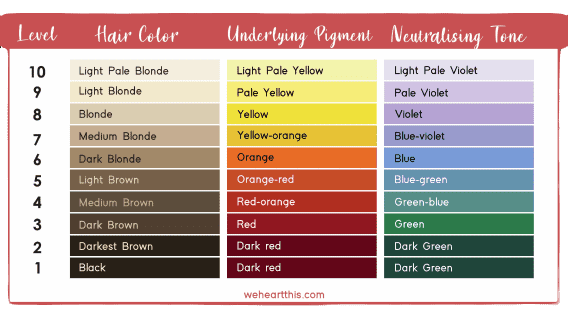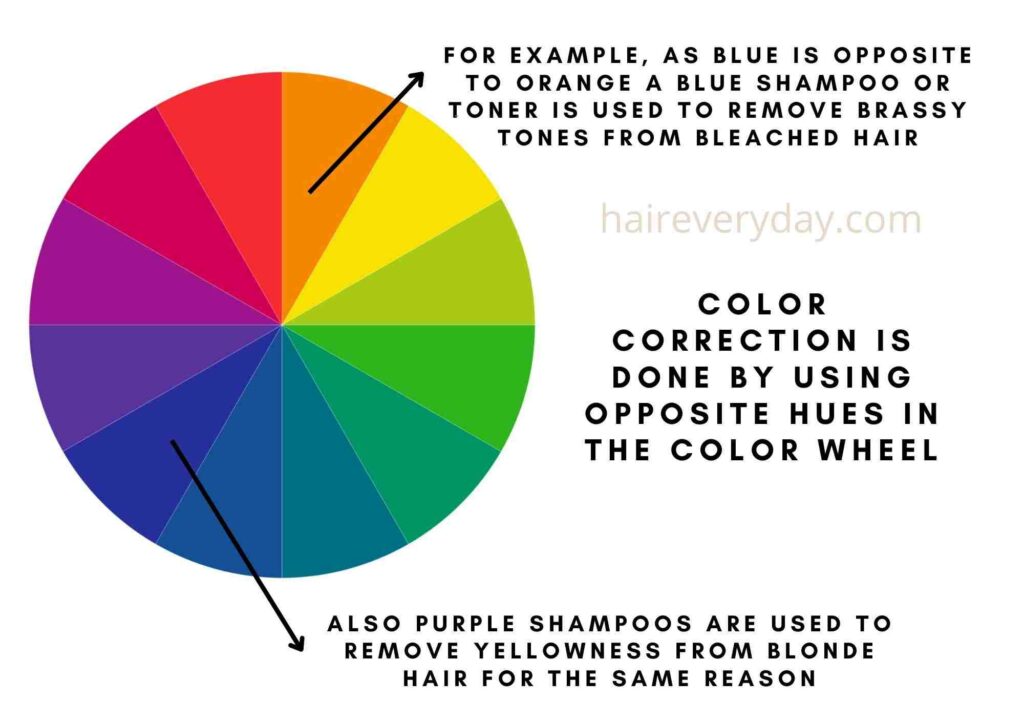How to find your best hair color using the hair color chart
Table Of Content

Once you have done that, you can use your blue based toner and all will be well. Note that these additives will tend to take your color level down by about 1 tone. These are double ashes and have a lot of neutralizing pigments build in.
Primary and Secondary Colors: The Basics.
In sections 1-6, we will explain how Color Theory theory and which colors you need to use to neutralize and how to use them. Remember, it’s always a good idea to consult a professional if you’re unsure about anything. They can provide personalized advice based on your hair’s specific needs. Before applying the toner to your entire head, do a strand test by applying the toner to a small, discreet section of your hair. This will let you see how your hair responds to the toner and if you’re happy with the result.

Using the Color Wheel When You Dye Your Hair at Home
In other words, the blonder the hair, the less of the additive you should add. Neutralizing these colors is something that all hairdressers need to be able to do. Then, in sections 7-9, we are going to suggest alternative pre-mixed toners which are simpler to use and which also work very well. Co-founder of Curl Centric® and Natural Hair Box, Kenneth has dedicated himself to promoting ethical and scientifically-backed hair care practices.

Complementary Colors
Another great option for canceling out green in blonde hair especially is purple shampoo or toner. If you have an unwanted orange undertone in your hair, opt for a cool toned blonde like ash blonde or platinum. If you’re a hair dresser or colorist, there’s a lot more to hair color theory than looking at opposite colors on the chart. Start by evaluating the natural hair levels you have, then consider your skin’s undertone. If you’ve got dark brown hair, looking for an ashy blonde look or want something in between, this chart helps you pick the perfect color every time. So what you can do is look up the specific brand’s hair color chart on their website or on online shops.
Warm and Cool Tones
Now, let’s look at how they correlate with a numbering system to create a hair color formula. Consider this your chance to demystify the salon experience, and your opportunity to 'try on' a hair color before you fully commit. Colorists, read on to brush up on the skills you’ve already expertly honed. There’s likely a plethora of purple and blue shampoos in your nearest drugstore to take away any gold and copper undertones in your hair.
The very first thing you must understand before coloring your hair is the levels of hair color. Natural hair colors are organized into levels from 1 – the darkest (black) to 10 – the lightest (blonde). You can discover your starting level by determining how close your hair is to black or blonde. For example, if your hair is a medium brown color, you may be a level 5, because it’s right in the middle between black and blonde. If your hair is a dark shade of blonde, you may be a level 7.
Apply the Toner
Levels 1 to 2 are black shades, 3 to 7 are brown shades, and 8 to 10 are blond shades. Stylists rely on the hair color wheel when formulating a specific shade or tone for their clients. They mix multiple tubes of dyes in certain ratios to produce the perfect tone that will enhance the current state of the hair. Rather than using one color tube, professional hairdressers formulate a specific color to enhance, cancel, or neutralize the unwanted or faded tones in the hair.
I Got My Season Colors Analyzed by a Pro. Here's How to Do It at Home. - Business Insider
I Got My Season Colors Analyzed by a Pro. Here's How to Do It at Home..
Posted: Mon, 11 Mar 2024 07:00:00 GMT [source]
There are lots of green toners available, but our favorite is Keracolor Color + Clenditioner because it not only deposits pigment, it also cleanses and conditions. If you have copper hair, your stylist will use an ash blue dye to give you the ash brown that you want. So when you want to highlight your eye color, you can choose a hair shade that complements your eyes.
Different hair color chart
Depending on your hair color, unwanted undertones, and intensity level, there's a perfect color-correcting product for you. However, there’s a lot of knowledge behind every formula they mix, even if they make each decision, suggestion and technique look utterly effortless. Used with semi and demi-permanent colors, and hair lighteners. Responsible for maintaining shades intact and can be used on any level. Also used with color extractors in removing artificial dyes or pigments as well.
If you have a warm skin tone, consider strawberry blonde, bronde, champagne blonde, ash brown, espresso, chocolate brown, burgundy, intense red, and cherry. Warm colors like honey blonde, golden blonde, caramel, chestnut, light golden brown, mahogany, butterscotch brown, copper, auburn, and ginger if you have a cool skin tone. Use the hair color wheel to determine the perfect shades to add to the formula that delivers your expected outcome. You may also consider the underlying pigment and neutralizing tone to get your desired look. To cancel out yellow tones in your hair, you would want to use a hair color or toner that is purple-based or has purple undertones.
The Colour Wheel (Image with permission from www.artyfactory.com, colour chart - readingagency.org.uk - Reading Agency
The Colour Wheel (Image with permission from www.artyfactory.com, colour chart - readingagency.org.uk.
Posted: Sun, 31 Mar 2024 21:43:00 GMT [source]
The colors are grouped into primary, secondary, and tertiary. They are the base colors and are used to produce secondary or tertiary colors. Imagine having a map that guides you to your desired hair color. With an understanding of our colors’ undertones, you can mix, match and create with confidence, knowing exactly how the colors on the wheel will play out in your hair. When intensifying the tone in your hair the color wheel acts as a reference for several shades that can be used for different results.
Its purpose is to display the relationship between different colors. The wheel starts with orange at the top right, and works its way through yellow, green, blue, purple, pink and red. Sad to say, you can’t just buy a hair color chart from a supermarket or beauty store.
Yellow, orange, red, and pink are the warm colors on the color wheel. In color wheel hair theory, those colors show you the underlying tones you need in natural-looking hair colors as well as vivid bright colors to look flattering on you. The rule of thumb is to get a shade or two lighter than your natural hair as you age. Take into account that your skin becomes lighter and your features get sharper with age, so avoid too dark colors. Choose the most flattering colors that suit your complexion, and you’ll never go wrong.
Comments
Post a Comment